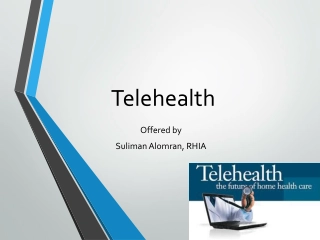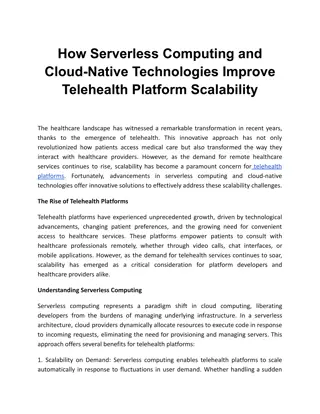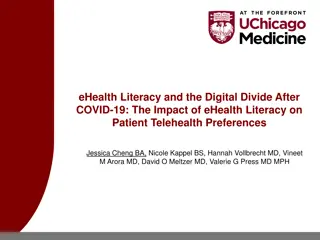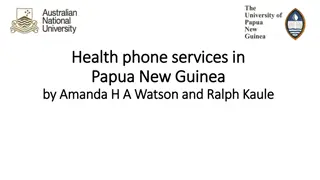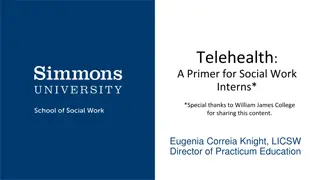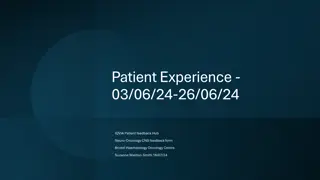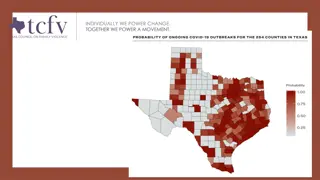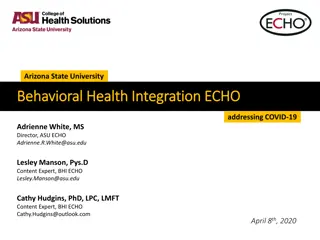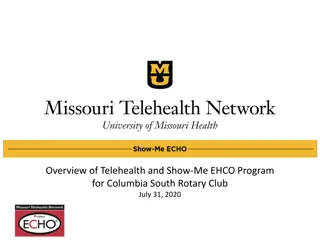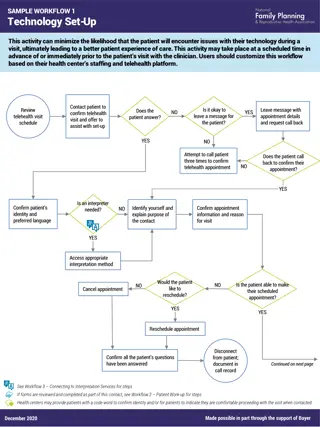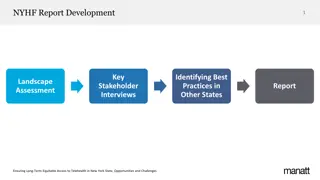Evolution of Telehealth in Oncology Amidst COVID-19
Explore how the COVID-19 pandemic has spurred the adoption of telehealth in oncology, as discussed by Dr. Samantha Jaglowski from The Ohio State University. Discover the rationale, barriers, implementation strategies, and future directions for telehealth in cancer care.
Download Presentation

Please find below an Image/Link to download the presentation.
The content on the website is provided AS IS for your information and personal use only. It may not be sold, licensed, or shared on other websites without obtaining consent from the author. Download presentation by click this link. If you encounter any issues during the download, it is possible that the publisher has removed the file from their server.
E N D
Presentation Transcript
How COVID-19 Changed Telehealth: An Oncologist s Perspective Samantha Jaglowski, MD, MPH The Ohio State University 1 1
Disclosures No disclosures relevant to this talk
Objectives To discuss the rationale for use of telehealth in cancer patients during the SARS-CoV2 pandemic To discuss historic and current barriers to the use of telehealth To discuss the Ohio State approach to implementing the use of telehealth for cancer patients To discuss potential future directions for telehealth
What we knew Potential for rapid spread, overwhelming health care system Cancer patients fare worse Most patients travel from areas with lower case numbers
What we knew Potential for rapid spread, overwhelming health care system Cancer patients fare worse Most patients travel from areas with lower case numbers We needed to be able to care for patients and keep them safe at home
Solution Telehealth
Medicare Telehealth Reimbursement before COVID- 19 Section 1834(m) of the Social Security Act (42 U.S.C. 1395m(m)) Established telehealth as a Medicare benefit Telehealth (synchronous) vs. Store-and-forward (asynchronous) Telehealth must use an interactive audio and video telecommunications system permitting real-time communication; store-and-forward only permitted for federal demonstration programs in Alaska and Hawaii
Medicare Telehealth Reimbursement before COVID- 19 1834(m) Restrictions and limitations Geographic location Originating sites (where patient is located) Eligible physicians and practitioners Distant sites (where provider is located) Eligible telehealth services CMS telehealth services list limited to specific HCPCS/CPT codes
Telehealth statutory changes Coronavirus Preparedness and Response Supplemental Appropriations Act of 2020 Includes the Telehealth Services During Certain Emergency Periods Act of 2020 Allowed for the waiver of Medicare limitations on telehealth services delivered by qualified providers during the COVID-19 emergency Permitted telehealth via telephone but only if such telephone has audio and video capabilities that are used for two-way, real-time interactive communication
Telehealth statutory changes Coronavirus Aid, Relief, and Economic Security Act Waives state licensure requirements for practitioners Waives the preexisting relationship requirement for telehealth services
CMS guidance on telehealth Telehealth reimbursement Visits are considered the same as in-person visits and are paid at the same rate Starting March 6, 2020, Medicare reimburses for professional services furnished to beneficiaries in all areas of the country in all settings No requirement that the patient be present at any particular kind of originating site
CMS guidance on telehealth Starting in 2019, Medicare reimbursement is available for: Virtual check-ins short patient-initiated communications with a healthcare practitioner Starting in 2020, Medicare reimbursement is available for: E-visits non-F2F patient-initiated communications through an online patient portal
CMS guidance on telehealth Virtual check-ins Available through synchronous or asynchronous technologies Telephone, audio/video, secure text messaging, email, or patient portals all permitted
CMS guidance on telehealth E-visits Patient-initiated online E/M service conducted via a patient portal Patient must generate the initial inquiry Communications can occur over a 7-day period Patient must verbally consent to the service
CMS guidance on telehealth OCR will not impose penalties against covered health care providers for the lack of a BAA with video communication vendors or any other noncompliance with the HIPAA Rules that relates to the good faith provision of telehealth services during the COVID-19 nationwide public health emergency Skype for Business/Microsoft Teams Updox Vsee Zoom for Healthcare Doxy.me Google G Suite Hangouts
Video Visit Delivery Options IHIS Integration External Desktop / Workstation Video Visit Visit Type Updox (3rd Party) Video Visit (3rd Party) Visit Type Haiku/Canto Laptop Other 3rd Party Video Visit Visit Type Video Visit (3rd Party) Visit Type Video Visit Visit Type IHIS Requirements Document in IHIS Encounter Document in IHIS Encounter Document in IHIS Encounter Registration Registration Documentation Documentation Laptop with Web Camera Installed Web Camera Device w/ Camera Device w/ Camera Hardware Requirements iOS Device Compatible Web Browser Chrome Recommended iOS Installed Software Installed Software 3rd Party Software Software Requirements Haiku/Canto IHIS Integration Tip Sheets Training Video 3rd Party Account Provider Requirements Updox Account MyChart Account Compatible Device E-Check In Compatible Device + Browser May Require 3rd Party App Download Patient Requirements |
Scheduling Workflow Organization-wide initiative Extend telehealth appts to patients video or telephone Exceptions require approval by department/specialty leadership where visits cannot be completed via telemedicine 35 |
Day of Visit Check-in Registration Workflow Advise patient how they ll connect with the provider MyChart VV They can click the video visit 15 minutes before the visit to join through MyChart 3rd Party VV The provider will send them a link via email or text at the time of their visit Telephone The provider will call them at the time of their visit 36 |
Patient Experience MyChart Upcoming Visits Screen eCheck-In Clinic Check-In Not Checked In 37 |
Patient Experience Video Visit Appointment Details Screen 38 |
Video Visits Technology Options 3rd Party Vendors Preferred Technology Platform Video Visits through IHIS COVID-19 pandemic has resulted in relaxed regulations for video visits Alternate options are secondary and most likely temporary Alternate platforms in order of preference: Updox- HIPAA compliant and easy for patients WebEx- Existing security agreement Skype - Existing security agreement 39 |
Updox Is the recommended 3rd party vendor for video visits Browser: 40 |
How did we do? >550,000 patients reported to CIBMTR
How did we do? >550,000 patients reported to CIBMTR
CMS guidance on telehealth Per CMS Administrator Seema Verma: 13,000 individuals received telehealth services per week before COVID-19 1.7 million received telehealth in the last week of April 22% of rural beneficiaries, 30% of urban beneficiaries received telehealth













